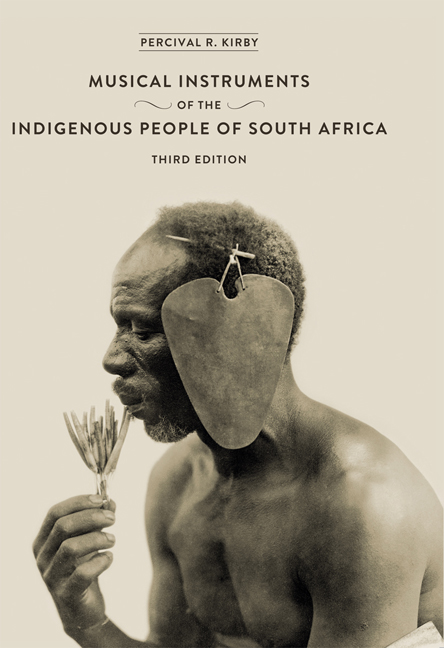Book contents
- Frontmatter
- Dedication
- Map
- Contents
- Foreword
- Preface to First Edition
- Preface to Second Edition
- Acknowledgements
- Acknowledgements to Third Edition
- List of Illustrations
- 1 Rattles and Clappers
- 2 Drums
- 3 Xylophones and ‘Sansas’
- 4 Bull-Roarers and Spinning-Disks
- 5 Horns and Trumpets
- 6 Whistles, Flutes, and Vibrating Reeds
- 7 Reed-Flute Ensembles
- 8 The ‘Gora’, A Stringed-Wind Instrument
- 9 Stringed Instruments
- 10 Bushman and Hottentot Violins and The ‘Ramkie’
- 11 Some European Instruments Played By Natives
- Appendix
- Addenda
- Index
8 - The ‘Gora’, A Stringed-Wind Instrument
Published online by Cambridge University Press: 21 April 2018
- Frontmatter
- Dedication
- Map
- Contents
- Foreword
- Preface to First Edition
- Preface to Second Edition
- Acknowledgements
- Acknowledgements to Third Edition
- List of Illustrations
- 1 Rattles and Clappers
- 2 Drums
- 3 Xylophones and ‘Sansas’
- 4 Bull-Roarers and Spinning-Disks
- 5 Horns and Trumpets
- 6 Whistles, Flutes, and Vibrating Reeds
- 7 Reed-Flute Ensembles
- 8 The ‘Gora’, A Stringed-Wind Instrument
- 9 Stringed Instruments
- 10 Bushman and Hottentot Violins and The ‘Ramkie’
- 11 Some European Instruments Played By Natives
- Appendix
- Addenda
- Index
Summary
THE unique character of the musical instrument known as the gora has for years attracted the attention of travellers in South Africa. It stands alone as an example of a stringed-wind instrument, and it is peculiar to this country.
In its original form the gora consisted of a slender bow of wood about three feet six inches long, tapering at its extremities in exactly the same way as the Hottentot or Bushman bow was tapered. A thin string of twisted sinew was prepared and one end of it was run through a tiny hole made in the slit and flattened barrel end of the quill of a feather, which had been cut into a roughly spatulate shape, and secured in that position. The shaft of the feather, from which the barbs had been removed, was lashed to one end of the stave of the bow by means of a piece of thin riem. The string was then drawn taut and fastened to the other end of the stave by being wound round it in such a way that the string might be tightened or loosened at will, and thus raised or lowered in pitch. The instrument thus constructed was held in such a manner that the quill lay between the lips of the player, though it did not touch them. By breathing in and out with force, the quill, and through it the string, was set in vibration, and yielded several of the partials of the harmonic series appropriate to the note to which the string had been tuned.
The first serious historical study of the gora was that of Balfour (1902), who collected and commented upon some fifteen references to its use, dealing chiefly with the instrument as found among the Bushmen and Hottentots, although adding some descriptions of its appearance among Chwana and Sotho. I myself went over the field afresh, taking advantage of the extremely comprehensive Gubbins’ Collection of Africana, and found extracts from twenty-three other authorities, including many which describe Bantu successors of the original Hottentot gora, and giving in detail the method of making and playing upon the instrument. In these two papers all the extracts referred to appeared in full. Since then I have obtained fresh information as to its use.
- Type
- Chapter
- Information
- The Musical Instruments of the Indigenous People of South Africa , pp. 232 - 257Publisher: Wits University PressPrint publication year: 2013



